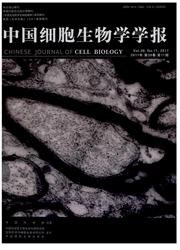

 中文摘要:
中文摘要:
冷冻干燥保存是长期保存人体红细胞的理想方案之一。冻干保护剂海藻糖渗入细胞内后,对细胞膜和细胞内物质有保护作用,其中的一个作用是增加细胞质的浓度,使冻干过程容易形成稳定的玻璃态。应用高渗法处理红细胞,通过考察胞内海藻糖含量、红细胞冻干后的存活率、腺苷三磷酸酶(ATPase)、超氧化物歧化酶(SOD)活力以及细胞形态变化,研究胞内海藻糖含量对红细胞冻干后活性的影响。结果显示:海藻糖对红细胞冻干具有明显的保护作用,随胞内海藻糖浓度升高,其保护性能逐渐增强;43.8mmol/L的胞内海藻糖浓度对红细胞保护最好,细胞存活率达到53.6%,形态保持良好,ATP和SOD活力均在正常的范围内。
 英文摘要:
英文摘要:
Freeze-drying is one potentially ideal technology for long-term preservation of living biological cells. To increase the survival and stability of human red blood cells (RBCs) after freeze-drying and rehydration, trehalose is introduced in RBCs using a hypertonic method before freeze-drying. The effects of intracellular trehalose concentration on RBCs after freeze-drying and rehydration are investigated. The results indicate that the survival of RBCs after freeze-drying and rehydration increases with the increment of intracellular trehalose concentration, the survival of RBCs after freeze-drying and rehydration is over 53.6% with 43.8 mmol/L of intracellular trehalose, the levels of ATPase and superoxide dismutase (SOD) are maintained close to the levels of fresh RBCs. Morphological study also confirms the results. It demonstrates that disiccation tolerance of RBCs increases along with the concentration of intracellular trehalose. Our study demonstrates that trehalose has protective effects on freeze-dried RBCs, the survival of freeze-dried RBCs depends on both extracellular and intracellular vitrification.
 同期刊论文项目
同期刊论文项目
 同项目期刊论文
同项目期刊论文
 Entropy generation theory for characterizing the freezing and thawing injury of biological materials
Entropy generation theory for characterizing the freezing and thawing injury of biological materials Numerical study on freezing-thawing phase change heat transfer in biological tissue embedded with tw
Numerical study on freezing-thawing phase change heat transfer in biological tissue embedded with tw Composition dependence of the Adam-Gibbs cooperative relaxation parameters in glycerol aqueous solut
Composition dependence of the Adam-Gibbs cooperative relaxation parameters in glycerol aqueous solut Flow boiling of liquid nitrogen in micro-tubes: Part II–Heat transfer characteristics and critical h
Flow boiling of liquid nitrogen in micro-tubes: Part II–Heat transfer characteristics and critical h Experimental study and analysis of mechanical properties of frozen rabbit aorta by fracture mechanic
Experimental study and analysis of mechanical properties of frozen rabbit aorta by fracture mechanic Effects of glycerol pretreatment
on recovery and antioxidant
enzyme activities of lyophilized red bl
Effects of glycerol pretreatment
on recovery and antioxidant
enzyme activities of lyophilized red bl Numerical study on the effects of large blood vessels on 3-D tissue temperature profiles during cryo
Numerical study on the effects of large blood vessels on 3-D tissue temperature profiles during cryo 3-D Numerical study on the Induced Heating Effects of embedded Micro/Nanoparticles on Human Body Sub
3-D Numerical study on the Induced Heating Effects of embedded Micro/Nanoparticles on Human Body Sub Water permeability parameters of dermal fibroblast employed in tissue engineering in subzero tempera
Water permeability parameters of dermal fibroblast employed in tissue engineering in subzero tempera Effects of freezing rates and dimethyl sulfoxide concentrations on thermal expansion of rabbit aorta
Effects of freezing rates and dimethyl sulfoxide concentrations on thermal expansion of rabbit aorta Freezing osteoblast cells attached to hydroxyapative discs and glass coverslips: Mechanisms of damge
Freezing osteoblast cells attached to hydroxyapative discs and glass coverslips: Mechanisms of damge Cryopreservation of tissue-engineered dermal replacement in Me2SO toxicity study and effects of conc
Cryopreservation of tissue-engineered dermal replacement in Me2SO toxicity study and effects of conc Study of heat shock response of human umbilical vein endothelial cells (HUVECs) using cDNA microarra
Study of heat shock response of human umbilical vein endothelial cells (HUVECs) using cDNA microarra Energy-Based Diagnostic and Treatment Techniques—— Possible Applications for Early Detection and Tre
Energy-Based Diagnostic and Treatment Techniques—— Possible Applications for Early Detection and Tre Single-phase pressure drop and heat transfer characteristics of turbulent liquid nitrogen flow in mi
Single-phase pressure drop and heat transfer characteristics of turbulent liquid nitrogen flow in mi Flow boiling of liquid nitrogen in micro-tubes: Part I–The onset of nucleate boiling, two-phase flow
Flow boiling of liquid nitrogen in micro-tubes: Part I–The onset of nucleate boiling, two-phase flow Immunologic Response Induced by Synergistic Effect of Alternate Cooling and Heating of Breast Cancer
Immunologic Response Induced by Synergistic Effect of Alternate Cooling and Heating of Breast Cancer Numerical simulation of selective freezing of target biological tissues following injection of solut
Numerical simulation of selective freezing of target biological tissues following injection of solut Disclosure of the significant thermal effects of large blood vessels during cryosurgery through infr
Disclosure of the significant thermal effects of large blood vessels during cryosurgery through infr Selective freezing of target biological tissues through injection of solutions with specific thermal
Selective freezing of target biological tissues through injection of solutions with specific thermal Numerical Study on Freezing Heat Transfer in cryosurgery with embedding Two Cryoprobes in Biological
Numerical Study on Freezing Heat Transfer in cryosurgery with embedding Two Cryoprobes in Biological 期刊信息
期刊信息
